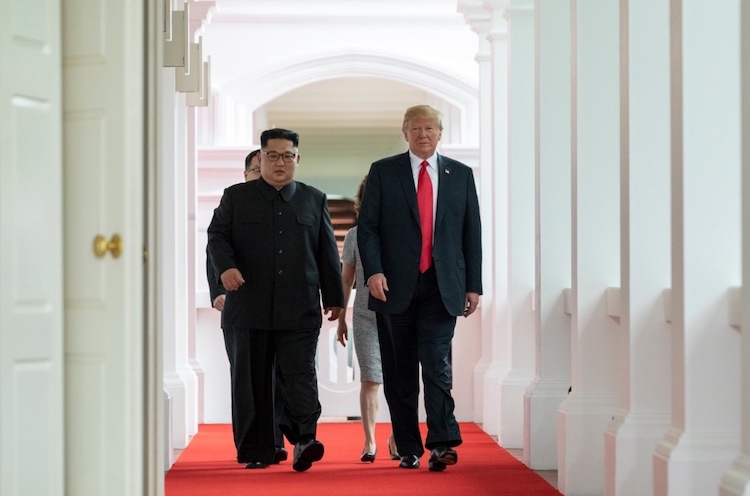By Sergio Duarte

The writer is Ambassador, former UN High Representative for Disarmament Affairs, and President of Pugwash.
NEW YORK (IDN) – The off-again, on-again meeting between President Donald Trump and Chairman Kim Jong-un which finally took place in Singapore on June 12 was undoubtedly an historic occasion. However, a sober analysis of its outcome can hardly conclude that it was either a success or a failure. Even so, the mere fact that after several weeks of mutual provocations and derogatory exchanges the two leaders agreed to meet in a cordial, almost congenial atmosphere is in itself an auspicious achievement.
Although the net result did not go beyond previous established positions by either side, there is reason to expect that further progress is possible, albeit perhaps not in the form of a “complete, verifiable and irreversible”, denuclearization of the Korean peninsula in the short run. After the meeting, the American president declared this would happen “very soon” but several ambiguities still persist. Even the term “denuclearization” seems to mean different things to each of the two sides and to interested parties in the region.
The joint statement released by the White House lists four points: a commitment by both parties to establish “new” U.S.-DPRK relations; the common will to join efforts to build lasting and stable peace in the Korean peninsula; the reaffirmation of the April 27 Panmunjom declaration through which the DPRK committed to “work towards” the complete denuclearization of the peninsula; and the recovery of the remains of American prisoners of war and missing in action, including the immediate repatriation of those already identified.
All of these points have been formulated before. There is no mention of any timetable for the fulfillment of these commitments and the statement goes on to assure that both leaders are committed to implement those stipulations “fully and expeditiously” and to hold follow-on negotiations with this objective, “at the earliest possible date”.
The statement also contains an explicit promise by President Trump to provide security guarantees to North Korea and the reaffirmation of Chairman Kim Jong-un’s “unwavering commitment” to complete denuclearization of the Korean Peninsula.
The joint statement recognizes that mutual confidence can promote the denuclearization of the peninsula but does not clarify what actions this would entail for either party, nor whether and to what extent it would affect the American forces deployed in or around the Republic of Korea. It will be interesting to see what concrete form related arrangements could take.
Another obscure point is the way in which compliance with the commitments by both sides will be verified. There is an urgent need to increase mutual confidence between the two sides given the current general erosion of trust in the maintenance of commitments made in the past.
Kim Jong-un can feel proud of having been recognized as an equal by the most powerful nation on Earth after having been branded as a “ruthless dictator” of a “rogue nation” for many years. Donald Trump can appear to his country’s public opinion as having done what his predecessors failed to do: take a meaningful first step toward North Korea’s nuclear disarmament and toward the normalization of relations between Washington and Pyongyang. Some of the preliminary demands mde previously, based on long-established values and perceptions, seem to have been dropped in favor of practical results.
Apparently surprising the Pentagon and the South Korean government, Trump gave Kim an important and not previously publicized concession: the suspension of the joint American-South Korean military exercises scheduled for August, a longstanding claim by the North.
According to the international press, the president of the U.S. commented that these “war games” were “provocative” and “tremendously expensive”. Meanwhile, Secretary of State Mike Pompeo was quick to announce that Washington will maintain the economic sanctions against North Korea until the “denuclearization” is completed. At a press conference in Seoul a day after the meeting the secretary admitted that the implementation of the deal will not be easy, but added that the United States hoped to achieve major nuclear disarmament of North Korea by the end of Trump’s first term in office.
Characteristically, the American president tweeted that there was no longer a nuclear threat from North Korea. Both the United States and the rest of the world wish that this is indeed so. But the wide majority of the world population hope for more: that the unprecedented meeting will signal the way to the end of the threat of the use of nuclear weapons by anyone through the complete elimination of all such weapons. Responsible leaders know that the supreme interests of their countries should not be placed above the legitimate aspirations of mankind as a whole. [IDN-InDepthNews – 16 June 2018]
Photo: Kim and Trump walking to the summit room during the DPRK–USA Singapore Summit on June 12, 2018. Credit: Wikimedia Commons.
IDN is flagship agency of the International Press Syndicate.
facebook.com/IDN.GoingDeeper – twitter.com/nukeabolition






